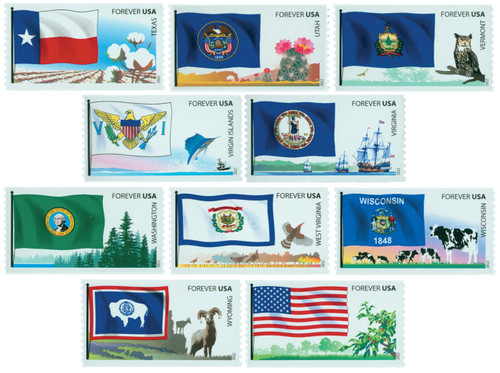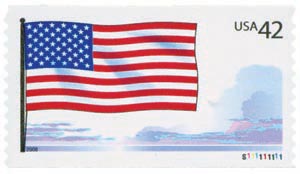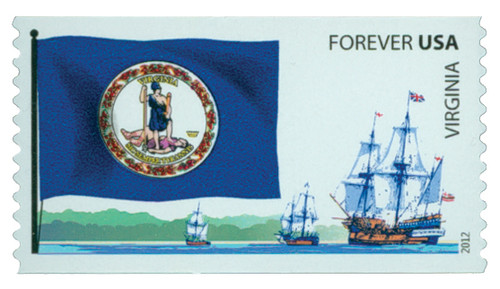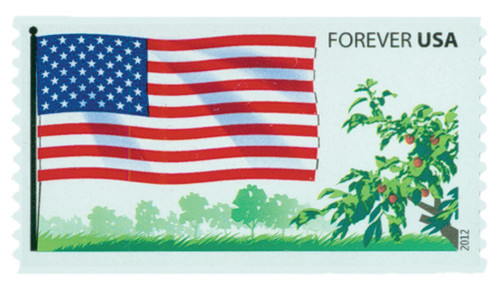
# 4323-32 - 2012 First-Class Forever Stamp - Flags of Our Nation: 6th Set
U.S. #4323-32
2012 45¢ Flags of Our Nation
Set VI (10 Stamps)
Issue Date: August 16, 2012
City: Sacramento, CA
Quantity: 250,000,000
Printed By: American Packaging Corp for Sennett Security Products
Printing Method: Photogravure
Color: Multicolored
Flags of Our Nation, Set VI: 2012 marks the sixth and final set of stamps in the series. The state and territory flags reflect the history of each region they represent. State seals are a common subject of many flags. A few designs are based on regimental banners used in the Civil War. The uniqueness of each state flag in the series reflects the diversity of the United States and its territories.
The Lone Star Flag was the national flag of the Republic of Texas, before the second-largest state joined the Union. When Texas became the 28th state in 1845, it adopted the same banner as its state flag. The blue stands for loyalty, the white represents purity, and the red is for bravery.
In 1912, the Sons and Daughters of Utah Pioneers prepared a flag to be presented to the battleship Utah. It featured the state seal encircled by a thin gold ring on a blue field. It differed from the flag adopted in 1896, which pictured the state seal as all white without a gold circle around it. The battleship’s flag became the official Utah state flag in 1913.
Vermont has had three flags since it became the fourteenth state in 1791. The first two flags were similar to the national flag, and residents wanted something unique. It was discovered that a flag design was authorized in 1838, but was not often used. It was the flag the Vermont regiments had carried during the Civil War, the Spanish-American War, and at the beginning of World War I. It consisted of the Vermont State Coat of Arms on a blue field. In 1919, the historic design became the official flag of Vermont.
The United States Virgin Islands is a territory of the United States located in the Caribbean Sea. Its flag’s background is white, which symbolizes purity. It pictures a familiar American symbol, the American Eagle with the U.S. shield on its breast. A sprig of laurel is held in one talon and three arrows in the other. The arrows represent the islands of St. Croix, St. Thomas, and St. John, the main islands in the territory. On either side of the eagle are the letters V and I, which stand for Virgin Islands.
Washington’s state flag is the only one with a green field and the only state flag picturing an actual person. Though this Northwestern state joined the Union in 1889, it did not adopt a flag until 1923. The state seal is in the center of the flag and pictures George Washington. Washington is the only state to be named after a President.
The citizens of western Virginia did not want to secede from the Union in 1861, so they left the Virginia Convention and formed their own state. On April 20, 1863, West Virginia became a free state of the United States. The original state flag had different images on the front and back. When it became too costly to produce the flag, the two designs were combined to create the present flag. The state coat of arms rests above branches of big laurel, the state’s flower. A red ribbon above the seal reads “State of West Virginia.”
The Civil War regiments from Wisconsin were anxious to have an official banner to display during battle. In 1863, the legislature voted on a resolution adopting a design that was already in use by some of the troops. The dark blue flag with the state’s seal in the center was officially adopted in 1913. To distinguish it from other state flags with seals, the word “WISCONSIN” and the year of statehood “1848” were added in 1979.
Wyoming did not have an official state flag in 1916, so the state regent for the Daughters of the American Revolution suggested a contest be held. A $20 prize was awarded at the state DAR convention to the winning flag design made by Verna Keays, a recent graduate from the Art Institute of Chicago. The design was adopted as the Wyoming state flag on January 13, 1917.
The Stars and Stripes is a proud symbol of the United States. It stands for freedom and democracy throughout the world. The thirteen stripes represent the country’s humble beginnings as thirteen small colonies on the Eastern Coast of a vast unexplored land. The 50 stars stand for the states of the Union, each of equal value to the country.
In 1893, English professor Katharine Lee Bates spent the summer teaching at Colorado College. While crossing the country on the train, she experienced the alabaster city of Chicago during the World’s Columbian Exposition and the amber grain fields of Kansas. While in Colorado, she took a trip up Pikes Peak and looked over the Great Plains. She wrote a poem, later entitled “America the Beautiful,” based on her experiences. The “Fruited Plains” in the first verse represent the bountiful crops that grow in the Great Plains.
The Flags Of Our Nation Series
The state flags had been honored on US stamps once before, in 1976 as part of the Bicentennial Series (US #1633-82). Those stamps marked an important first – they were America’s first 50-stamp se-tenant. The sheet featured all of the state flags in the order the states were admitted to the Union.
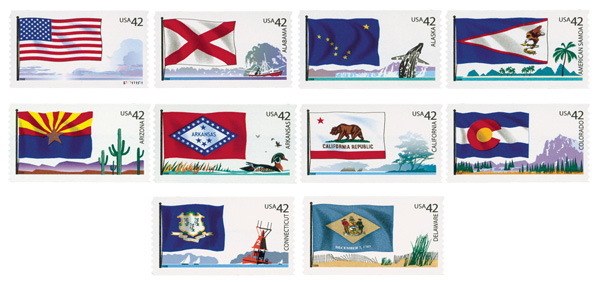
In 2008, the USPS again decided to honor the state flags but in a different format. These stamps represented a US postal first. They have the beauty and historic significance of commemorative stamps, but were issued as se-tenant (face-different attached) definitive coil stamps.
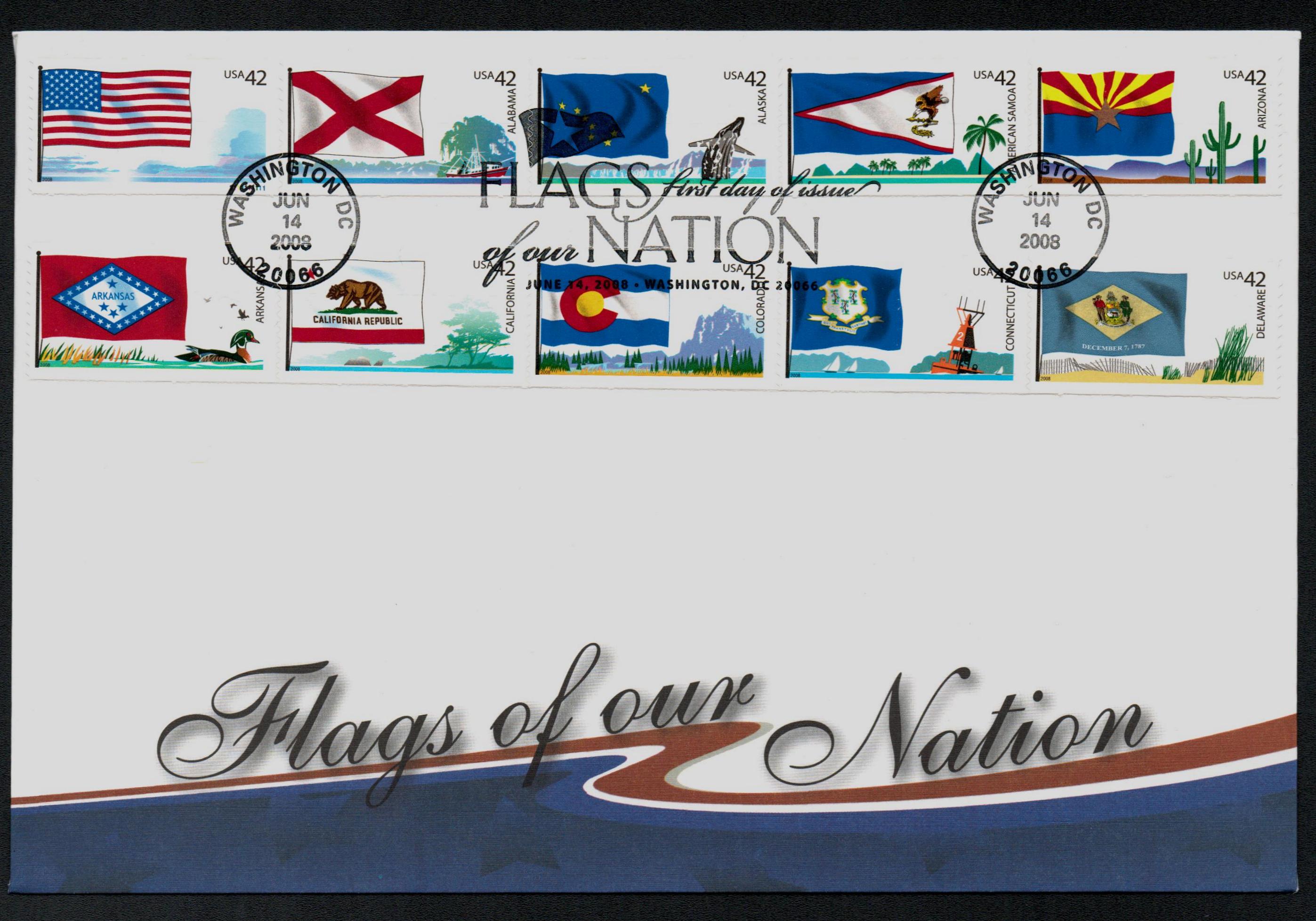
The new series was called “Flags of Our Nation” and would consist of 60 stamps total – 50 featuring state flags, five territorial flags, the District of Columbia flag, and four US flags flying over American landscapes described in “America the Beautiful.” The stamps in the new set would be issued in alphabetical order by state or territory. Each stamp would feature a flag and a “snapshot” from the state or territory. These snapshots would include scenic areas, plants, animals, and more.
The first set of stamps was issued on Flag Day, June 14, 2008 at the National Postal Museum in Washington, DC. It featured the flags of Alabama through Delaware, American Samoa, and the American flag with “spacious skies.”
In speaking about the stamps, a USPS representative said, “Flags are our nation’s greatest symbols for unity and pride and the values we hold dear. The Postal Service is proud to present this tribute as we honor our nation’s flags.” That same day, special events were held in the nine state capitals whose flags were featured in that first set of stamps.

The second set in the series was issued later in 2008, on September 2. As with the first set, there were special ceremonies in the state capitols of those states featured on this set of stamps. The stamps in this set featured the flags of Florida through Kansas, the District of Columbia and Guam.

Initially, two sets of 10 stamps were supposed to be issued each year for three years. However, in 2009 it was decided that each year would only include the issue of one set of 10 stamps. The third set was issued on August 6, 2009 at the American Philatelic Society Stamp Show in Pittsburgh, Pennsylvania. These stamps featured the flags of Kentucky through Missouri as well as the US flag with “amber waves of grain.”
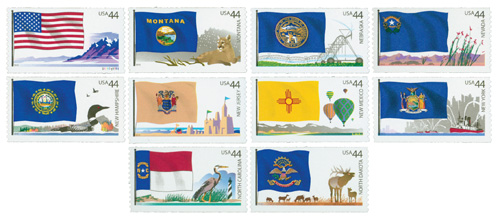
The fourth issue in the series was released on April 16, 2010 at the Mega Stamp Show in New York City. These stamps featured the flags of Montana through North Dakota with the US flag above “purple mountain majesties.”
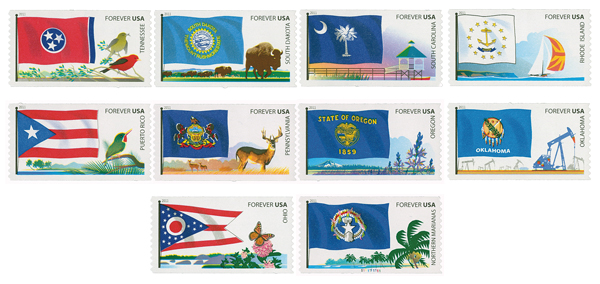
The fifth set was issued on August 11, 2011, at the American Philatelic Society Stamp Show, in Columbus Ohio. These were the first in the series to be issued as Forever stamps. Featured on these stamps were the flags of Ohio through Tennessee, Puerto Rico, and the Northern Mariana Islands.
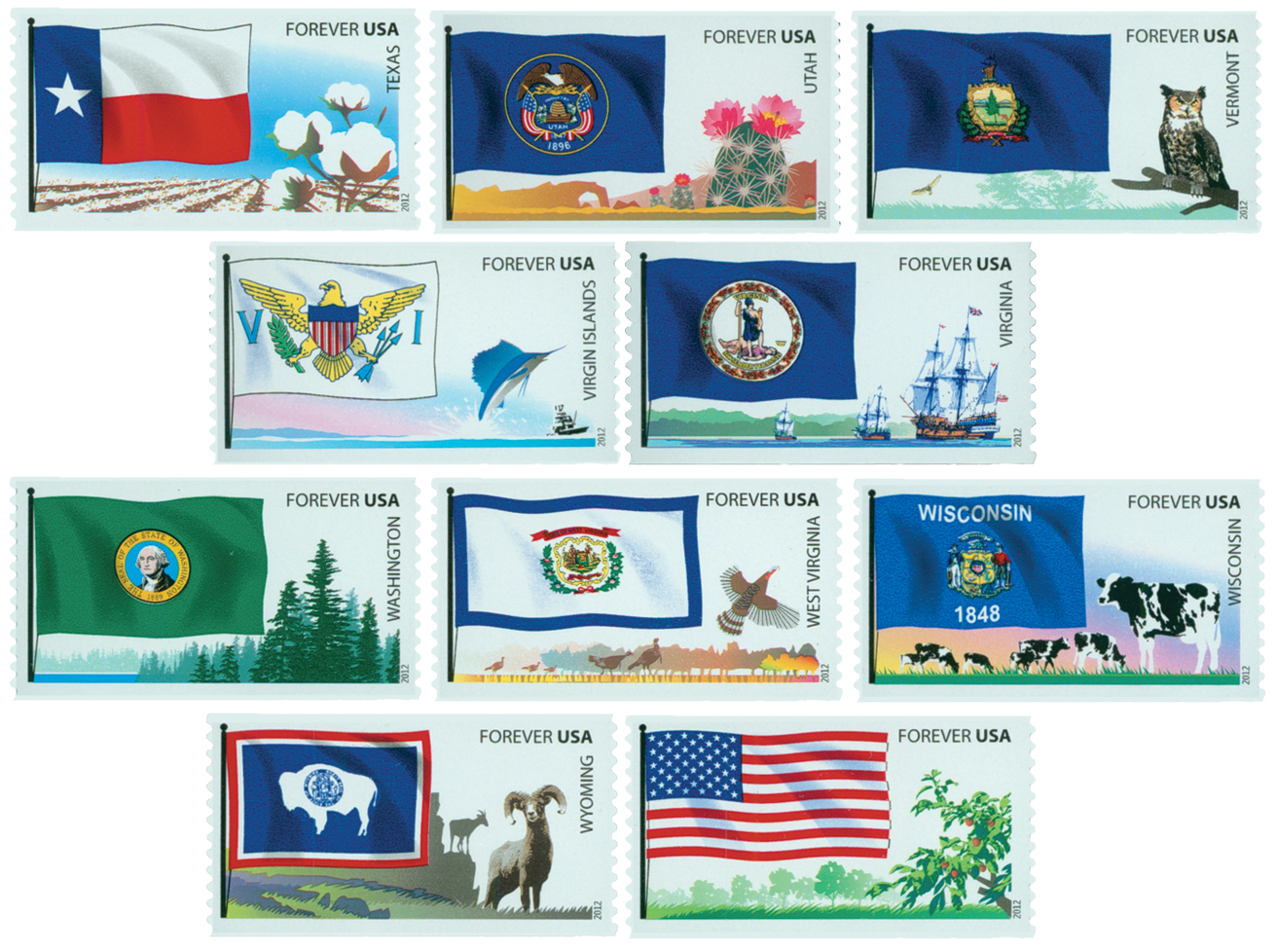
The series came to a close on August 16, 2012, with the sixth and final set. These stamps were issued at the American Philatelic Society Stamp Show in Sacramento, California. Featured on these stamps were the flags of Texas through Wyoming, the Virgin Islands, and the US flag with “the fruited plain.”
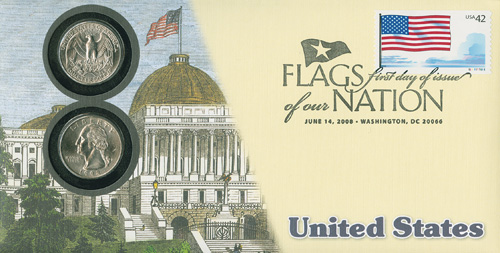
Click here for more Flags of Our Nation Coin Covers as well as single stamps and sets.
Click here to get the complete set of 60 Flags of Our Nation stamps in one convenient set.
U.S. #4323-32
2012 45¢ Flags of Our Nation
Set VI (10 Stamps)
Issue Date: August 16, 2012
City: Sacramento, CA
Quantity: 250,000,000
Printed By: American Packaging Corp for Sennett Security Products
Printing Method: Photogravure
Color: Multicolored
Flags of Our Nation, Set VI: 2012 marks the sixth and final set of stamps in the series. The state and territory flags reflect the history of each region they represent. State seals are a common subject of many flags. A few designs are based on regimental banners used in the Civil War. The uniqueness of each state flag in the series reflects the diversity of the United States and its territories.
The Lone Star Flag was the national flag of the Republic of Texas, before the second-largest state joined the Union. When Texas became the 28th state in 1845, it adopted the same banner as its state flag. The blue stands for loyalty, the white represents purity, and the red is for bravery.
In 1912, the Sons and Daughters of Utah Pioneers prepared a flag to be presented to the battleship Utah. It featured the state seal encircled by a thin gold ring on a blue field. It differed from the flag adopted in 1896, which pictured the state seal as all white without a gold circle around it. The battleship’s flag became the official Utah state flag in 1913.
Vermont has had three flags since it became the fourteenth state in 1791. The first two flags were similar to the national flag, and residents wanted something unique. It was discovered that a flag design was authorized in 1838, but was not often used. It was the flag the Vermont regiments had carried during the Civil War, the Spanish-American War, and at the beginning of World War I. It consisted of the Vermont State Coat of Arms on a blue field. In 1919, the historic design became the official flag of Vermont.
The United States Virgin Islands is a territory of the United States located in the Caribbean Sea. Its flag’s background is white, which symbolizes purity. It pictures a familiar American symbol, the American Eagle with the U.S. shield on its breast. A sprig of laurel is held in one talon and three arrows in the other. The arrows represent the islands of St. Croix, St. Thomas, and St. John, the main islands in the territory. On either side of the eagle are the letters V and I, which stand for Virgin Islands.
Washington’s state flag is the only one with a green field and the only state flag picturing an actual person. Though this Northwestern state joined the Union in 1889, it did not adopt a flag until 1923. The state seal is in the center of the flag and pictures George Washington. Washington is the only state to be named after a President.
The citizens of western Virginia did not want to secede from the Union in 1861, so they left the Virginia Convention and formed their own state. On April 20, 1863, West Virginia became a free state of the United States. The original state flag had different images on the front and back. When it became too costly to produce the flag, the two designs were combined to create the present flag. The state coat of arms rests above branches of big laurel, the state’s flower. A red ribbon above the seal reads “State of West Virginia.”
The Civil War regiments from Wisconsin were anxious to have an official banner to display during battle. In 1863, the legislature voted on a resolution adopting a design that was already in use by some of the troops. The dark blue flag with the state’s seal in the center was officially adopted in 1913. To distinguish it from other state flags with seals, the word “WISCONSIN” and the year of statehood “1848” were added in 1979.
Wyoming did not have an official state flag in 1916, so the state regent for the Daughters of the American Revolution suggested a contest be held. A $20 prize was awarded at the state DAR convention to the winning flag design made by Verna Keays, a recent graduate from the Art Institute of Chicago. The design was adopted as the Wyoming state flag on January 13, 1917.
The Stars and Stripes is a proud symbol of the United States. It stands for freedom and democracy throughout the world. The thirteen stripes represent the country’s humble beginnings as thirteen small colonies on the Eastern Coast of a vast unexplored land. The 50 stars stand for the states of the Union, each of equal value to the country.
In 1893, English professor Katharine Lee Bates spent the summer teaching at Colorado College. While crossing the country on the train, she experienced the alabaster city of Chicago during the World’s Columbian Exposition and the amber grain fields of Kansas. While in Colorado, she took a trip up Pikes Peak and looked over the Great Plains. She wrote a poem, later entitled “America the Beautiful,” based on her experiences. The “Fruited Plains” in the first verse represent the bountiful crops that grow in the Great Plains.
The Flags Of Our Nation Series
The state flags had been honored on US stamps once before, in 1976 as part of the Bicentennial Series (US #1633-82). Those stamps marked an important first – they were America’s first 50-stamp se-tenant. The sheet featured all of the state flags in the order the states were admitted to the Union.

In 2008, the USPS again decided to honor the state flags but in a different format. These stamps represented a US postal first. They have the beauty and historic significance of commemorative stamps, but were issued as se-tenant (face-different attached) definitive coil stamps.

The new series was called “Flags of Our Nation” and would consist of 60 stamps total – 50 featuring state flags, five territorial flags, the District of Columbia flag, and four US flags flying over American landscapes described in “America the Beautiful.” The stamps in the new set would be issued in alphabetical order by state or territory. Each stamp would feature a flag and a “snapshot” from the state or territory. These snapshots would include scenic areas, plants, animals, and more.
The first set of stamps was issued on Flag Day, June 14, 2008 at the National Postal Museum in Washington, DC. It featured the flags of Alabama through Delaware, American Samoa, and the American flag with “spacious skies.”
In speaking about the stamps, a USPS representative said, “Flags are our nation’s greatest symbols for unity and pride and the values we hold dear. The Postal Service is proud to present this tribute as we honor our nation’s flags.” That same day, special events were held in the nine state capitals whose flags were featured in that first set of stamps.

The second set in the series was issued later in 2008, on September 2. As with the first set, there were special ceremonies in the state capitols of those states featured on this set of stamps. The stamps in this set featured the flags of Florida through Kansas, the District of Columbia and Guam.

Initially, two sets of 10 stamps were supposed to be issued each year for three years. However, in 2009 it was decided that each year would only include the issue of one set of 10 stamps. The third set was issued on August 6, 2009 at the American Philatelic Society Stamp Show in Pittsburgh, Pennsylvania. These stamps featured the flags of Kentucky through Missouri as well as the US flag with “amber waves of grain.”

The fourth issue in the series was released on April 16, 2010 at the Mega Stamp Show in New York City. These stamps featured the flags of Montana through North Dakota with the US flag above “purple mountain majesties.”

The fifth set was issued on August 11, 2011, at the American Philatelic Society Stamp Show, in Columbus Ohio. These were the first in the series to be issued as Forever stamps. Featured on these stamps were the flags of Ohio through Tennessee, Puerto Rico, and the Northern Mariana Islands.

The series came to a close on August 16, 2012, with the sixth and final set. These stamps were issued at the American Philatelic Society Stamp Show in Sacramento, California. Featured on these stamps were the flags of Texas through Wyoming, the Virgin Islands, and the US flag with “the fruited plain.”

Click here for more Flags of Our Nation Coin Covers as well as single stamps and sets.
Click here to get the complete set of 60 Flags of Our Nation stamps in one convenient set.

